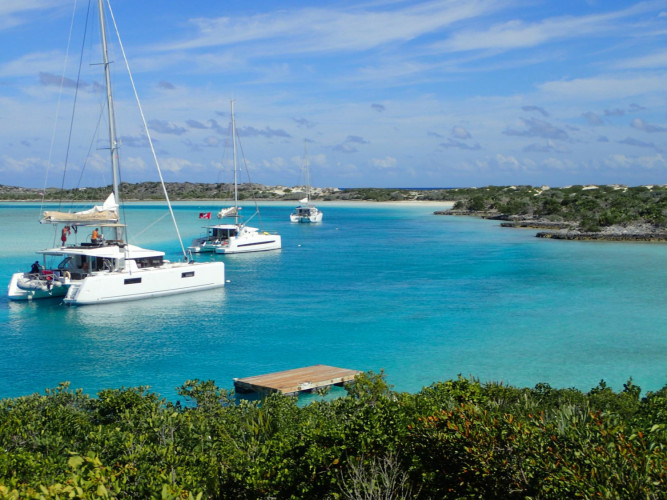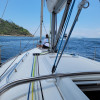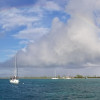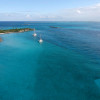You read our article, “How do you get started bareboat chartering?”
You’ve gone through all of the classes and you are certified!
What should you do next?
-
If possible, co-captain.
If you have an opportunity to head out with a captain interested in showing you the ropes for 7+ days, DO IT. Nothing can replace on-the-water experience. Ensure you set expectations up front with the captain, so he or she knows you want to be part of the entire planning and chartering process.
Make sure you do as much sailing, anchoring, mooring, docking, and navigating as possible as co-captain. You can pay a captain if you don’t have a friend who is qualified and willing. Do as much as possible by yourself and practice communicating with other members of the crew on specific tasks like docking, mooring, anchoring, tacking, and jibing. Once you’re alone with your parents or drunken friends, you better be good at single-handing everything or giving orders people can follow. Screaming at people from the helm is not super effective!!
-
Select a crew.
For your first trip, it would be wise to have experienced crew and/or captains on the boat. You will also want to consider personalities. For most people, being a captain is different than being a crew member. You’ll be asking people to do things, and their decisions will dramatically affect you. When things get intense, you’ll want people who can listen and act quickly. Know-it-alls, jokesters, and lazy people can really shake an uncertain captain.
Be honest with yourself – How do you react under pressure? Can you trust these people to get serious and act quickly when you need them? If you make a mistake, run aground, the weather sucks, someone get seasick, someone gets hurt, or some other unplanned event happens, how will your crew deal with it? How will you deal with them?
Your crew needs to understand that this is a working trip, you’re in charge, and everyone needs to pitch in. We’ll do another article, “Captain’s Guide: Selecting and Preparing Your Crew.”
-
Select a smart location.
For your first charter, you’ll want sailing grounds that are easy to navigate and have the resources you’ll need if you have issues. For this, we can’t recommend the British Virgin Islands (BVI) highly enough. For a full rundown of why we suggest the BVI as your first captain experience, see our article, “Captain’s Guide: Six Reasons to Choose the BVI for Your First Charter”
-
Select the right yacht.
If you’ve selected your crew and location, a yacht should be pretty easy. If you took the bareboat class from ASA, they talked about selecting crew and yachts. Think about your crew again – What can they handle? If they are used to luxury, you better get a water maker and air conditioning!
Space on boats, even large catamarans, is smaller than many people are used to. We highly recommend avoiding using the saloon as a bedroom, as it makes for an uncomfortable situation for everyone. Take a smaller crew or charter a bigger boat.
-
Work with a charter broker.
You can do all of your own research, scour the charter companies’ websites, and book directly with a charter company. Another option is working with an independent broker. Brokers know the industry, players, yachts, and locations better than anyone. They have strong relationships with the charter companies and if something goes wrong, the broker will have a lot more leverage than someone chartering for the first time!
-
Provision grocery items.
Provisioning can be daunting and complex. We recommend using a service that will deliver everything to the boat. Some charter companies will even put away your provision delivery on the boat, in the refrigerator, and in the cabinets. The more you can have done BEFORE you get to the base, the better.
Think about your trip and do some math. Think about your meal planning now. How many meals will you eat on the boat? Will those meals create leftovers that you can use? Will you really go through three kinds of cereal? We have had MANY trips where we ended up with hundreds of dollars of excess groceries. Luckily, the staff at the base are happy to take those off your hands!
Drinks are another major consideration. We find that we drink way more than we think we will. Do you have water, soda, beer, wine, and/or cocktail drinkers? Water and light beer (also known as water) go down very fast. With eight people, seven days, and five beers per day, you’ll need 280 beers! If you plan for that only to find half the people hate beer…not good. TIP: We find that the large 5-liter water bottles are MUCH easier to work with, cheaper, and far less waste than using 12 oz. bottles.
“But can’t we just buy more when we need it?” Maybe or maybe not. If you are sailing in New England, you’ll probably have a lot of options for stores on your route. If you’re sailing in the Exumas, it’s likely you’ll go many days without access to a store. Take this into consideration before you decide to buy one bottle of vodka for four people. Run out of alcohol and you may have a mutiny on your hands!
“Can we drink the water from the water maker?” Here’s the thing – You don’t know where this boat has been. If the water maker fills the same water tank as the nasty hose at the dock…think twice before using the water maker for drinking water. We use the “water maker water” for dishes, showers, etc. We avoid drinking it.
You can find more provisioning information in our article: Provisioning for a bareboat sailing charter made easy.
-
Plan your trip and create your float plan.
Hopefully this is obvious, but it’s important to understand the charts, locations, provisions available, and what you’ll do at each stop, before you depart the marina, or even your home. You’ll likely have limited time, a very expensive boat, an inexperienced crew, and you may be new to the area. This is not a good time to “wing it.”
Start by understanding what the area has to offer. Figure out where the really cool/beautiful spots are. Where are the best bars and restaurants? Where can you SCUBA dive, snorkel, party, etc.? Are there any fun events/festivals going on in the area while you’re there?
During the planning phase, don’t worry about the detailed daily itinerary, days, meals, etc. Just get a feeling for what’s in the area and take notes on “must hit” spots. Plot them as points in Navionics, Google Maps, etc.
Next, consider the winds and begin plotting course options that get you to all of your hot spots. Try to avoid plotting a course that takes you directly into the prevailing winds. Sometimes the most direct path isn’t the best for sailing.
Consider the crew and amount of sailing you would like to do per day. Remember you also want to have some time to snorkel, swim, etc. so try not to sail dawn until dusk every day. Also remember that you need to get to your destination at the end (probably before sunset). Don’t plan everything with such a tight schedule that there’s no wiggle room if you have problems.
Finally, go over your itinerary with the charter company. Ask them if your plan makes sense and be open to their advice. I have ignored them in the past and wished I listened. Locals will know the conditions, fun spots, dangers, and they will have other insider knowledge that you can help you greatly.
-
Assign jobs/duties to the crew.
Docking, anchoring, and mooring are some of the most intense experiences for captains. You DO NOT want to have your crew looking at you for commands while you’re trying to bring the boat in. Give everyone responsibilities for the WHOLE trip in advance. Assign crew members to be responsible for bow fenders, stern fenders, anchor, dinghy duties, etc. If you will be picking up mooring balls, who has the boat hook, who has port/stern lines, and who will be giving the helm directions?
If everyone has jobs laid out ahead of time, they can be mentally prepared, look things up online, and ask questions so they understand their responsibilities. You can always let someone else try a different job if they are interested, but when something “hits the fan” it’s good to ask everyone to go to their stations and be ready!
-
Build a chore chart.
Some say the best way to lose a friend is to live with them. You can also lose friends by chartering boats with them.
A charter vacation is also a working vacation. Unless you have a chef, captain, and hired crew, someone needs to cook, sail, and clean! On our trips we try to keep it simple and give everyone a day or two where they are responsible for cooking and cleaning. When we have eight people on a one-week trip, we typically assign one day to each person, or two days for each couple. This way, everyone has days they work and the rest of the time they can pitch in as needed.
One big reason we suggest chore days is because everyone is different. Some folks are overly helpful and some are passive. If you don’t set up responsibilities, the overly helpful will do everything and grow irritated with the people not helping. Those who are passive will think there wasn’t anything to do because So-and-So was already on top of it.
The key to these trips is for everyone to pitch in. Even if it isn’t “your day,” you should pick up after yourself, help out, and remember, your day is coming!
-
Select and test an anchor alarm.
Anchoring can be stressful. You are dropping a rather small object to the ground and assuming it will hold a 15+ ton boat in wind and waves for 12+ hours. Depending on the type of sea floor, the depth, the amount of scope used, and the conditions, your anchor may or may not hold. Good luck sleeping through the night knowing this tidbit!
Luckily, anchor alarms offer some peace of mind. An anchor alarm is a simple concept. Your phone or tablet (we use multiple devices) will mark the location of the anchor and your boat. As your boat swings around the anchor, it tracks your movements. If the boat drifts too far from the anchor point, it will alarm and let everyone know that you are dragging or drifting.
If you get comfortable with your anchor alarm(s), and you know you can trust them, you can sleep easy through the night knowing that you’ll be alerted if there is a problem.
TIP: Depending on the size of the boat and how loud your devices are, you can set up a baby monitor with the microphone near the device and the speaker in your cabin to ensure you hear the alarm.
-
Have fun.
If you choose a reasonable boat, location, itinerary, and crew, you should be able to relax and have a great time!










